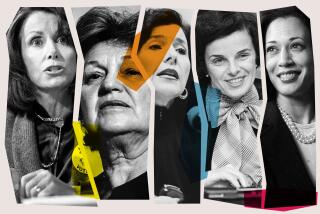Women in L.A. History : The early days of Southern California were marked by women who contributed to the area’s development as inventors, lawyers, authors and philanthropists. As Women’s
History Month comes to a close, here is a look at a few of them:
* CHARLOTTA BASS, 1875--1969
A pioneering African American journalist, Bass was widely known for her leadership in civil rights, voting and housing rights, and as a labor activist. She was the owner, publisher and editor of the California Eagle, which was, from 1879 to 1964, the longest continuously publishing black newspaper on the West Coast. Her fearless stance against the Ku Klux Klan led to a confrontation with eight white-sheeted men. The incident ended when she pulled a gun from her desk and aimed it at them. She was the first black woman candidate for vice president, on the Progressive Party ticket in 1952, when she was 77.
* INA COOLBRITH, 1841--1928
Coolbrith, the niece of Mormon church founder Joseph Smith, came to California on the Overland Trail, settling in Los Angeles as a child with her family in 1855. Her career as a poet began with the publication of her early poems in local newspapers. In 1915, she was named California’s first poet laureate. Much of her life was spent in the Bay Area, where she was the first public librarian in Oakland and the librarian--and an honorary member--of the exclusively male Bohemian Club. She encouraged young writers such as Jack London to pursue literary careers. Her friends from the arts included such luminaries of the time as Bret Harte, Mark Twain, Isadora Duncan, Mary Austin and Joaquin Miller.
* CLARA SHORTRIDGE FOLTZ, 1849--1934
Foltz was the first woman admitted to the Bar in California, but only after she and another woman, Laura Gordon, drafted a law to eliminate discrimination by sex or race, lobbied for its passage in the Legislature and persuaded the governor to sign it. Until that time, only white men could practice law in the state. When the state-run Hastings Law School in San Francisco refused them admission, she and Gordon sued and won the right for women to attend. She was posthumously awarded a law degree from Hastings in 1991. In addition to a successful law practice in Los Angeles and other cities, she was co-founder and editor of the Daily Bee, a short-lived newspaper in San Diego in the 1880s.
* MARY EMILY FOY, 1862--1962
The first woman director of the Los Angeles library, Foy also pursued a career in education as a teacher and principal. She was a leader in the women’s suffrage movement and a delegate to the 1920 Democratic presidential convention. She was a member of the Friday Morning Club, a politically and socially active group of women, whose members founded the first public kindergartens in California, juvenile courts and a “protective league” for abused children. Her longtime residence, a stately Victorian originally at 7th and Figueroa Streets, was designated a historic structure and moved to Angelino Heights in 1992.
* JESSIE BENTON FREMONT, 1824--1902
A trailblazer in her own right, Jessie Fremont was the wife of explorer John C. Fremont. Based in St. Louis, she not only served as secretary for her husband’s 1843 expedition to the West, but was instrumental in overcoming bureaucratic snags that might have aborted it. She wrote about her husband’s travels, turning his dry reports into exciting tales that captured the imagination of the nation. She shared an adventurous life with Fremont through such events as the discovery of gold in California, his terms as governor and U.S. senator, and his unsuccessful presidential campaign. Her writing supported the couple in their later years.
* BIDDY MASON, 1818--1891
Mason was born a slave in 1818, came West with her owner in 1848, and in California in 1856, successfully sued in court for her freedom. Earnings from her work as a nurse and midwife enabled her to buy property, including a parcel between Spring Street and Broadway for $250 that is now part of a $24-million complex that contains a park in her honor.
A legend in her day who became a wealthy philanthropist, she helped found Los Angeles’ First African Methodist Episcopal Church, the first elementary school for black children, a disaster center for residents left homeless by flooding, an orphanage and a day-care center.
* EULALIA PEREZ DE GUILLEN, 1768--1878
As the original llavera , or keeper of the keys, at the San Gabriel Mission, Perez de Guillen was responsible for the mission’s storehouses and money room during the height of its role as a center of commerce. She managed many of the manufacturing and industrial activities of the mission and oversaw the activities of many of the Indian women there. She was also a highly regarded nurse and midwife. As compensation for her long service to the church, Perez de Guillen was deeded Rancho San Pasqual, 3 1/2 square leagues of land (about 15,400 acres), which included the original site of the city of Pasadena.
* HARRIET RUSSELL STRONG, 1844--1926
Widowed in 1883, Strong decided to farm Rancho del Fuerte, 220 acres near Whittier that she and her husband had purchased from Gov. Pio Pico. There she hosted such early suffragists as Susan B. Anthony and Anna Shaw. Strong was among the first to plant citrus, walnuts, pampas grass and fig trees--crops that became a mainstay for the area’s agriculture. The marketing of her crops led to success in business and admittance as the first woman member of the Los Angeles Chamber of Commerce. She was awarded patents for her canal and reservoir systems, and her proposals were used in the development of the Colorado River water project. --NONA YATES
More to Read
Sign up for Essential California
The most important California stories and recommendations in your inbox every morning.
You may occasionally receive promotional content from the Los Angeles Times.










